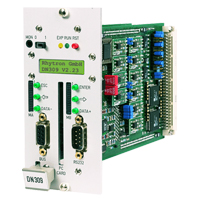DN309 – Digital Controller
DN309 – Digital Controller
The DN309 module can control electromechanical as well as hydraulic drives, whereby the special demands encountered in hydraulic applications have been taken into account.

The DN309 module is an extremely compact digital controller developed for very demanding drive applications. It can control electromechanical as well as hydraulic drives, whereby the special demands encountered in hydraulic applications have been taken into account. The module’s hardware allows the control of systems using digital and/or analog sensors.
A typical application using digital sensors is the control of position and speed of two hydraulic cylinders operated in either synchronized or non-synchronized mode. The preferred displacement sensors for this application are absolute ultrasonic transducers with SSI interface, integrated in the cylinders and connected directly to the DN309. Auxilliary parameters like pressure and acceleration can be measured using analog sensors which are also fed directly into the system.
Another application is the p/Q control of a hydraulic displacement pump with analog sensors. In this application the mass flow, pressure and power control modes are combined with one another. System variables like rotation angle, power, pressure and their setpoints are entered over the analog sensor circuitry. As an option, the pulse encoder can be used for power calculation at variable rotational speed or for control of this rotational speed. Proportional valves, control valves or servo valves can be used for the control of the hydraulic drives.The DN309 can output the usual ±10V as well as the ±100mA signals required for the direct control of servo valves.
The software is especially well suited for the operation of hydraulic cylinders. This is especially the case for their control systems and is extremely important for these applications, where heavy loads are to be moved by very long cylinders and where, because of hydromechanical constraints, a very low system resonant frequency is demanded. Under these operating conditions, additional software modules will stabilise the control function:
- Positional condition controller with direction sensitive premptive control action.
- Integrated speed control using displacement differentiation or tachometer.
- Integrated acceleration control using accelerometer or area corrected differential pressure.
- Integration of the valve characteristics using adjustable linearizing.
- Enabling or disabling of the I-parameter as a function of the operating conditions.
- Combined positional control / force limiting control / pressure control / speed control.
